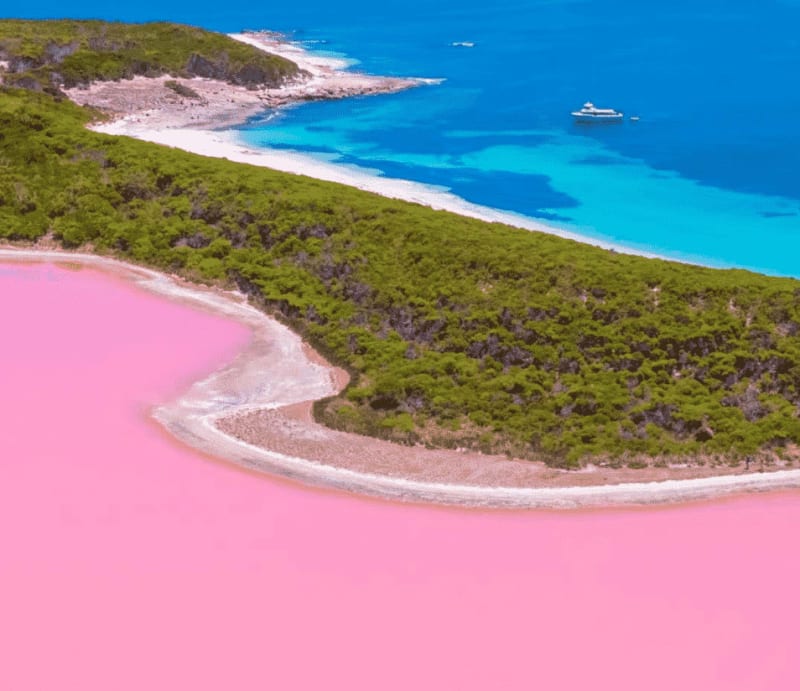

Australia's Most Popular Pink Lakes
In Australia's breathtaking landscapes, a unique phenomenon manifests itself in the form of vibrant pink lakes - a result of the proliferation of a microorganism known as Dunaliella salina.
Resilient to the inhospitable conditions of saline environments like salt pans and lagoons, this organism produces a red pigment called beta-carotene to defend itself from the intense sun rays. When present in sufficient amounts, this algae gives the water a distinctive, rosy tint.
Moreover, the salt crust that forms on the lake's surface, a mixture of salt and the algae's pigment, also contributes to the lake's color. Typically, these lakes that exhibit a striking shade of pink are shallow and abundant in salt, providing an ideal habitat for the algae to flourish.
As the intense sunlight beats down, the algae release more beta-carotene, intensifying the lake's hue. It's worth noting that the color of the lake can fluctuate depending on various factors such as the time of day, weather conditions, and the density of the algae population.

Lake Hillier
Lake Hillier is an enchanting lake located in Australia and is a breath-taking sight to behold. With its captivating pink hue, it is a unique and mesmerising natural wonder. It has earned the title of one of the most iconic destinations for travellers and nature enthusiasts alike and is a must-visit for anyone looking to capture the beauty of Australia. The lake's salt content is so high that swimming is not possible but visitors can enjoy its beauty from a boat. Along with the majestic beauty, visitors can explore the rich wildlife, breathtaking views and stunning landscapes surrounding the lake. Lake Hillier is definitely an unforgettable experience filled with natural wonders.

Hutt Lagoon
Hutt Lagoon, also known as Pink Lake, is a shallow coastal lake located in Western Australia. The lake is known for its vibrant pink color, which is caused by the presence of a type of algae called Dunaliella salina. The algae produce a red pigment called beta-carotene, which gives the water its pink hue. The color can vary depending on the time of year and the amount of sunlight the lake receives. The lake is also home to a large number of crustaceans, including brine shrimp and blue-green algae. The lake is a popular tourist destination and is also used for salt production.

Lake Eyre
Lake Eyre is a large salt lake located in South Australia, and is the lowest point in Australia at 15m below sea level. The lake is usually dry, but fills with water infrequently, usually as a result of heavy rainfall in the surrounding area. When the lake does fill with water, it attracts large numbers of waterbirds and other wildlife. The lake is also home to a number of islands, including the largest one called Kati Thanda-Lake Eyre.

Lake Bumbunga
Lake Bumbunga is a small salt lake located in the state of South Australia, near the town of Lochiel. The lake is known for its changing colors, which can range from a deep red to a vibrant pink.

Lake Macdonnell
ake Macdonnell is a large salt lake located in South Australia. The lake is known for its large salt pans, which are visible from space, and its large population of brine shrimp. The lake is also home to a number of migratory bird species, including the banded stilt and the red-necked avocet.

Lake Hart
Lake Hart is a salt lake located in South Australia. It is one of the many salt lakes in the area and is known for its large salt pans, which are visible from space.

Lake Warden
The Lake Warden System, which includes the Lake Warden salt lake and its surrounding wetlands, is located in the Goldfields-Esperance region of Western Australia. It has been designated as a protected nature reserve, and was recognized by the Ramsar Convention as an area of international importance on June 7, 1990, and has been listed as Ramsar Site 485. Additionally, it is also recognized as a wetland of importance by the Directory of Important Wetlands in Australia (DIWA).

West Gate Park
The color change of the lake is primarily caused by high levels of salt. The lake already contains a significant amount of salt as it is a salt lake, but it only appears pink when the salt levels are particularly high. Other factors such as high temperatures, abundant sunlight and low rainfall also contribute to the color change. Algae present in the salt crust of the lake produce a red pigment called beta carotene during photosynthesis, leading to the formation of a striking deep-pink colored lake.

Pink Lake Dimboola
The lake is a popular destination for birdwatching and is home to a variety of species of waterbirds and waders. The lake is also a popular spot for fishing and boating. The surrounding area is also popular for camping and hiking.

Murray-Sunset National Park Lakes
The park is known for its vast landscapes and salt lakes, including Lake Crosbie, Lake Tyrell, and Lake Becking. These lakes are among the largest salt pans in Victoria and are popular for birdwatching and wildlife viewing. They are also known for their unique pink and white colored salt crust, which is caused by the presence of a type of algae called Dunaliella salina.

Lake Albert
Lake Albert is a lake located in the western part of Victoria, Australia. It is a large, shallow lake that is part of the Wimmera-Mallee region and is fed by the Wimmera River. The lake is a popular destination for boating, fishing, and birdwatching. It is home to a variety of waterbirds and waders, including pelicans, swans, and migratory shorebirds. The lake is also a popular spot for camping and picnicking. Lake Albert is also known for its unique pink and white colored salt crust.